
10/23/06 - 11/1/06
john benjamin cribbs
In October 2006, Funderburg and Cribbs set out to watch at least 200 movies over the course of the next 200 days. They both watched a different slate of films and wrote about every single one; from epic high art masterpieces such as Fassbinder's 15 & 1/2 hour Berlin Alexanderplatz to goofy teen comedies like Savage Steve Holland's worthy One Crazy Summer to idiotic dreck like Open Water 2. In sections spanning 10 days at a time, The Pink Smoke is reprinting their writings about the grueling experiment in cinematic endurance.
<<click here for 10/13/6 - 10/22/6>>
10.23.06. The Hills Have Eyes (2006).
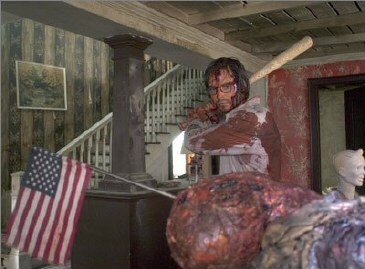 The only good excuse for a straight-up remake is to improve upon a film with a good premise but flawed execution, therefore Craven's film was ripe for the picking. This version is almost fanatically true to the original for the first half, with a surrogate replacement for all seven of the first movie's victims (the bespectacled hero is slightly retooled as a pussy liberal forced to take up arms à la Dustin Hoffman in Straw Dogs.) It even features the same "You know what Freud would have said about your rattlesnake obsession?" line from the original that makes me think Debbie Harry will randomly pop up to answer, "And he'd be right. I admit it: I live in a highly excited state of overstimulation." It follows the 1977 film scene-for-scene, dead-dog-for-dead-dog until the trailer assault, in which the rape is as ambiguous as ever, then it goes to work solving the problematic third act.
The only good excuse for a straight-up remake is to improve upon a film with a good premise but flawed execution, therefore Craven's film was ripe for the picking. This version is almost fanatically true to the original for the first half, with a surrogate replacement for all seven of the first movie's victims (the bespectacled hero is slightly retooled as a pussy liberal forced to take up arms à la Dustin Hoffman in Straw Dogs.) It even features the same "You know what Freud would have said about your rattlesnake obsession?" line from the original that makes me think Debbie Harry will randomly pop up to answer, "And he'd be right. I admit it: I live in a highly excited state of overstimulation." It follows the 1977 film scene-for-scene, dead-dog-for-dead-dog until the trailer assault, in which the rape is as ambiguous as ever, then it goes to work solving the problematic third act.
Another couple of bombs must've been set off since 1977, because the monsters of the 2006 Hills - which really plays up the nuclear testing angle - look more like Sloth from Goonies and act like Leatherface than a bunch of hairy, chortling inbreeds. Alexandre Aja uses elements of the 'Saw in reworking the conclusion, sending the hunted travelers on a blood-soaked baptism of fire towards salvation. The focus is more on survival than revenge (although the triumphant music accompanying the hero's pumping of shells into a villain hardly seems justified.) Overall, it makes for a much better film, although certain elements that worked in the first movie are missing, like the two siblings using their mother's corpse as bait to bring their oppressors down for a final stand. I'm not sure why, but I really love the moment early in the movie when the car tires blow and they're going to crash when Ted Levine shouts, "Watch the baby!" It was a humanizing thing for his character - he plays a hardass ex-cop - that made his subsequent burning alive all the more disturbing (take that, Rusty Nail.)
10.24.06. The Prestige.
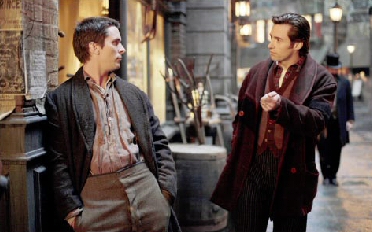 Christopher Nolan's turn of the century dueling magicians showcase isn't quite the Batman vs. Wolverine spectacular everyone was hoping for. At its best, the movie merits a label which has become a signature of the director's career: "passable entertainment." "Good magician, terrible showman" is how someone describes Christian Bale's character, and I think that Nolan has the same problem. He makes good looking movies with very workable concepts, employs attractive sets and casts, but can't bring it all together. He has editing problems and a terrible sense of pacing, and his seemingly mad ambition to tell a sweeping epic creates a jumbled storyline, a good example being the useless Tesla-Edison rivaling inventor subplot of this movie.
Christopher Nolan's turn of the century dueling magicians showcase isn't quite the Batman vs. Wolverine spectacular everyone was hoping for. At its best, the movie merits a label which has become a signature of the director's career: "passable entertainment." "Good magician, terrible showman" is how someone describes Christian Bale's character, and I think that Nolan has the same problem. He makes good looking movies with very workable concepts, employs attractive sets and casts, but can't bring it all together. He has editing problems and a terrible sense of pacing, and his seemingly mad ambition to tell a sweeping epic creates a jumbled storyline, a good example being the useless Tesla-Edison rivaling inventor subplot of this movie.
Bale and Hugh Jackman are assistants to Ricky Jay (very inventive cameo there) who become professional and personal enemies after Bale accidentally (?) causes the death of Jackman's wife (it is not a good year to be in love with Hugh Jackman, either as a lover onscreen - here, X-Men 3, The Fountain - or as a fan offscreen - here, X-Men 3, The Fountain.) They humiliate each other pubicly, share a lovely assistant/mistress (the better-seen-than-heard Sco Jo) and obsess over each other's secrets, most centrally the "Transported Man" trick. The same kind of conventional twists and turns that marred Memento are applied, although one of them is kind of dark and engaging. I do wish that there were real life feuding magicians, and that David Blaine's nemesis would destroy him forever.
10.25.06. Sileni (Lunacy).
"There is no knowing what one eats," wrote Edgar Allan Poe in "The System of Dr. Tarr and Prof. Fether," one of the stories adapted by Jan Svankmajer in his excellent new film. The director, who has a unique relationship with food, appears in a forward to introduce Lunacy as a horror film, and it turns out to be the kind where meat slithers and dances and fucks and eats and regurgitates of its own accord in that beautiful, terrifying Svankmajer fashion. Meanwhile, the talking meat of the movie is a young man named Jean who, returning home from his mother's funeral, strikes up a strange acquaintanceship with a gleeful misanthrope based on the Marquis de Sade. His experiences with the Marquis lead him to a bizarre ritualistic orgy, a restaging of Poe's "Premature Burial" and finally to the asylum at Charenton where the inmates have taken over ("Surely someone would have noticed," Jean naively reassures himself.)
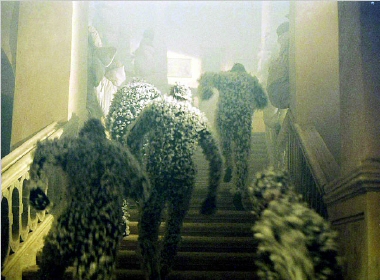 At his most Bunuelian (whose later films were particularly food-related and in whose The Milky Way a fictional version of de Sade also turns up), Svankmajer here serves up a political horror movie in which what Jean first perceives as threatening and perverse - the Marquis' madhouse of a society - seems liberating compared to the maniacal governing of the institution's true caretakers, revealed as a horde of hideous figures clad in chicken feathers. Which is preferable: unbridled, depraved freedom (the essential de Sade philosophy, referred to by Poe as the "soothing system") or the confining, manipulative mutilation of the body and mind? Or is there a third option, one that "combines and exacerbates the very worst aspects of the other two?" Animated brains, eyes, tongues, chickens and (of course) raw steaks frolic around the sets in parallel digression to Svankmajer's surrealistic social study, which is characteristically disturbing and hilarious.
At his most Bunuelian (whose later films were particularly food-related and in whose The Milky Way a fictional version of de Sade also turns up), Svankmajer here serves up a political horror movie in which what Jean first perceives as threatening and perverse - the Marquis' madhouse of a society - seems liberating compared to the maniacal governing of the institution's true caretakers, revealed as a horde of hideous figures clad in chicken feathers. Which is preferable: unbridled, depraved freedom (the essential de Sade philosophy, referred to by Poe as the "soothing system") or the confining, manipulative mutilation of the body and mind? Or is there a third option, one that "combines and exacerbates the very worst aspects of the other two?" Animated brains, eyes, tongues, chickens and (of course) raw steaks frolic around the sets in parallel digression to Svankmajer's surrealistic social study, which is characteristically disturbing and hilarious.
Also, my birthday is coming up soon, so if anyone can find a set of the cards from the opening credits - which depict the painful steps of Dr. Coulmiere's treatment and look awesome - they'd make a great gift.
10.26.06. Jackass Number Two.
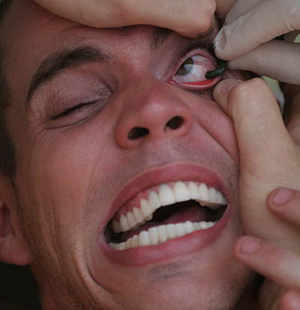
Could it be that the Jackass crew is more successful at making Dogme 95 films than those guys in Denmark? Filmed on location - check. Hand-held camera - check. Shot in color with no optical work in the "here and now" - check, check, and check. No stars - even Spike Jonze is hidden behind sagging prosthetic boobs. Realism? You don't get any realer than putting a leech on your eye or a fish hook through your cheek or drinking beer with your anus (all care of Steve-O naturally.) As in previous Jackass installments, the most interesting aspect is the group dynamic: how they constantly reel each other in (in Steve-O's case, literally) and set the bar higher on every challenge, relishing their senselessness even as they expose their own humanizing foibles like Bam Margera's paralyzing ophidiophobia.
Ringleader Johnny Knoxville is at his Wile E Coyotest, performing stunts that movies like Nacho Libre now do CG, putting himself in front of a 1500 pound charging yak, and nearly dying for his art when the side of a rocket explodes inches from his torso. Face-to-cement collisions, fat guy bungee jumping and the inevitable pranks on Margera's tolerating parents...everything we expect to follow the opening chords of "Corona" ensues in this double entendre-titled sequel (man, that reads like a sound bite.) The climatic gag, which gets turned on prankster Ehren McGhehey, plays out terrifically and John Waters, not to be outdone by scenes of horse shit eating and horse semen drinking, presents a magic trick.
10.27.06. Dillinger.
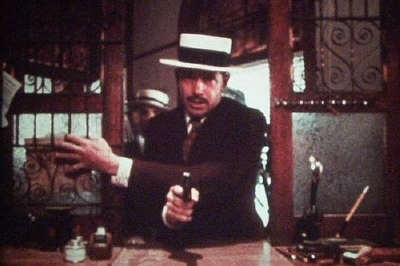 John Milius' Dillinger, an estranged cousin to Bonnie and Clyde and The Wild Bunch, may not be as revered or revolutionary as either of those films, but it more than matches them in pure vim and vigor. Warren Oates' John Dillinger, telling his robbery victims "you're buying stories to tell your grandchildren," plays up his own legend, and the movie is happy to oblige. It's guilty of more than a few sentimental touches, most notably the forced love subplot between Dillinger and Billie Frechette (Michelle Phillips, whose handsome features were never utlitized much on film, probably because she can't act.) The mythical wooden gun prison breakout is not only played up, but Dillinger stops to rob a bank in town during his escape! The final biographical lines claim that G-man Melvin Purvis committed suicide with the gun he used to kill Dillinger - funny, since three other feds did the actual shooting outside the Biograph theater.
John Milius' Dillinger, an estranged cousin to Bonnie and Clyde and The Wild Bunch, may not be as revered or revolutionary as either of those films, but it more than matches them in pure vim and vigor. Warren Oates' John Dillinger, telling his robbery victims "you're buying stories to tell your grandchildren," plays up his own legend, and the movie is happy to oblige. It's guilty of more than a few sentimental touches, most notably the forced love subplot between Dillinger and Billie Frechette (Michelle Phillips, whose handsome features were never utlitized much on film, probably because she can't act.) The mythical wooden gun prison breakout is not only played up, but Dillinger stops to rob a bank in town during his escape! The final biographical lines claim that G-man Melvin Purvis committed suicide with the gun he used to kill Dillinger - funny, since three other feds did the actual shooting outside the Biograph theater.
But then what public enemy biopic doesn't relish the legend (in the allegedy well-researched Pat Garrett and Billy the Kid, which for the record is great, Bob Dylan plays a fictional character made up by Garrett for his unreliable autobiography), and Dillinger makes up for its liberties with action: plenty of gunfights, a getaway executed with a fresh corpse draped over the windshield and a wildly satisfying scene of Oates beating the shit out of Richard Dreyfuss, playing "Baby Face" Nelson. Milius may have emulated Penn and Peckinpah, but the movie is just as inspired by the melodramas and war films of his youth (the final third of the film is liked a gangster The Great Escape.) Oates is surprisingly suave, and Ben Johnson plays Purvis as perfect gentleman and vengeful psychopath. The ill-fated gang members are excellently played by Geoffrey Lewis, John Ryan and Harry Dean Stanton ("Step on it, I got his gumball machine!")
10.28.06. Conan the Barbarian.
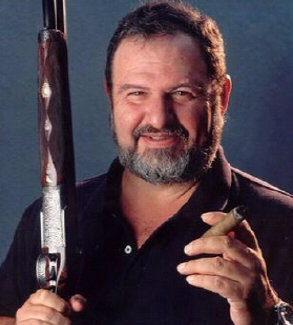
Crom! That's right: it's a Milius double header (and I don't mean the snake.) Before he was a co-founder of the Ultimate Fighting league and inspiration for the John Goodman character in The Big Lebowski, Milius brought his right wing hysteria and Zen anarchy to the sword and sandals equivalent of Superman, a film version of Robert E Howard's weird fiction hero, Conan the Barbarian. Arnold Schwarzenegger seems completely liberated in his fur and leather outfits, flexing his muscles for the movie that made him a star. I can't help but picture the governor's office in California decorated with glowing torches and animal hides, Schwarzenegger himself sitting atop a mighty throne with half naked women chained on either side.
Opening coyly with Nietzsche's "That which does not kill us makes us stronger" tag, the film follows Conan's will to power after his family is wiped out Whack-a-Mole style by James Earl Jones and his Spinal Tap-lookin' cronies. He cries out for vengeance and more stylish headbands, gaining strength of body and mind to the infectious beat of Basil Poleduris' epic score. Milius' heavy hand is evident throughout: you believe that the Red Dawn auteur would love nothing more than to crush his enemies, see them driven before him and hear the lamentation of their women. Because the movie's co-written by Oliver Stone, there's a healthy amount of homoeroticism (particularly in a scene where Conan is apparently propositioned by a priest) to the extent that Arnold's sweaty pecks cause a distraction to the unfolding story of the hero versus false religions (he's crucified for his trouble - get it?) One great moment: Conan getting high on black lotus and punching out a camel.
10.29.06. Flags of Our Fathers.
The worst scene in any war film is from We Were Soldiers, when photojournalist Barry Pepper experiences a profound revelation and embraces his responsibility to document the bravery of our men in combat. The moment is hilarious: Pepper superimposed over slow-motion soldiers snapping away to the sound of patriotic strings. Clint Eastwood must have felt a similar call to duty, and consequently there are no less than 50 of those ridiculous moments in his trashy melodrama, sickly sentimental deconstructions of the soldier's struggle that sit smugly on screen as if this was a new approach to the subject. Really, war is hell? That's an interesting viewpoint and I'd like to subscribe to this movie's newsletter. I can see why a rich draft dodger like Spielberg would naively think that portraying American soldiers as soulful innocents would somehow enlighten people as to how much it would suck to have strangers firing giant machine guns at them, but you'd think a grizzled bastard like Eastwood would resist the temptation to make his characters look like a bunch of pussies (unsurprisingly, Spielberg co-produced.) Samuel Fuller would have shot this movie in the head.
Speaking of Spielbergo, another embarrassing war movie moment is the infamous "Tell me I've been a good man" beginning and end of Saving Private Ryan. Those scenes at least had the benefit of being bookends: in Flags, the tired, traumatized geezers, "voices of the greatest generation," pop up every five minutes, and they all sound like a white Morgan Freeman. Eastwood once said he wanted to shoot Michael Moore, but Jesus even Moore has never been this manipulative. Every single war movie cliche is dragged like a howling commando from the vaults. The Japanese could not have been more demonized if they had large buck teeth and devil horns like in the old Disney propaganda cartoons (it almost seems like the Japanese POV companion film Letters from Iwo Jima is being made to justify their depiction in this movie.) The landmine end of an officer (played, appropriately, by Barry Pepper) sets off a messy montage of individual troopers being offed, each death followed by one of the main characters shouting, "(Name of soldier), NOOOOOO!"
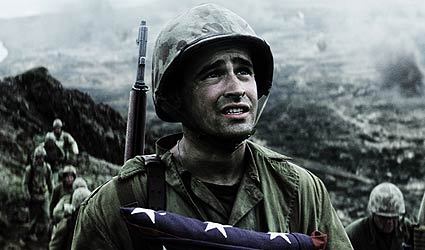
Compare a movie like this to, say, Don Siegel's Hell is for Heroes - old war movies that are considered so irrelevant and outdated today - and the case could be made that it's better to overglamorize war than to have a bunch of losers whining like children as the shrapnel explodes around them, not as some nostalgic reverie either, but as an experience. That pretty much covers the battle scenes...they're actually masterful next to what occupies most of the excruciating running time: a leering Jesse Bradford, a vacant Ryan Philippe, and a never-been-drunk Adam Beach (reprising his exact role from Windtalkers) moving from one flag waving ceremony to the next growing more and more disillusioned about the cause and asking, "Are we really heroes?" which might have been fine if the movie didn't spend 3 hours reassuring, "Yes, yes, YES!"
10.30.06. Imprint.
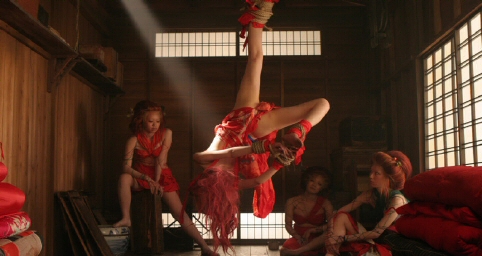
Whether dropping Takashi Miike's episode of Masters of Horror was a publicity stunt or a genuine concern for how Showtime viewers would respond to fetuses being plopped into the river like tiny malformed bear turds, it was a mistake. For one thing, why would they bother getting him involved from over in Japan just to dump his work? The series, which has gotten more jeers than cheers, could have used a prolific and versatile filmmaker like Miike, one used to working in all different formats - film, video, television - to take advantage of the very limiting constraints of the show's budget. Although Imprint is nothing exceptional (it's what you'd expect from Miike TV: amazing visuals, gruesome thrills, incest and mutilation and psychosis), it's far more interesting than his disappointing segment of Three Extremes. Billy Drago (here used more effectively than he has been since threatening Fabiana Udenio with rape and murder), playing a journalist who finds "almost everyting strange," spends the night with a deformed prostitute who tells him the grisly tale of his former lover's demise. As in One Missed Call, things lurk out of shadow in the background and Miike's obsessesion with fucked up family structure comes into play. The narrative plays out as a series of three different flashbacks, each uncovering more of the girl's perverse history like a Miike-guided Rashomon. His standard horrific torture scene, his special brand of comedy - there's a classy "pop!" sound effect as a screeching woman gives birth - and all manner of blood and fluids make their way into the hour-long installment.
Interestingly, it turns out Mick Garris created and executive produced Masters of Horror? No wonder he got to direct some...
10.31.06. Brain Damage.
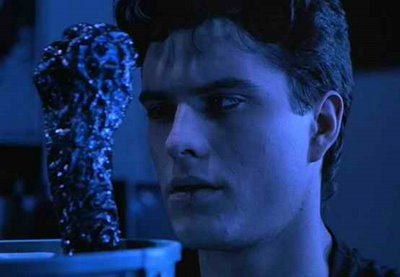 What happened to Frank Henenlotter? It's been 15 years since his last film, and I'm worried he's not going to make any more movies for no apparent reason, like Robert Bresson or Russ Meyer. It's strange that his work and reputation seem so neglected by the horror-loving community* (number of Henenlotter titles on Bravo's 130 Scariest Moments? Zero.) I know he's now big into B-movie print conservation, but his place is behind the camera making his "weird little movies."
What happened to Frank Henenlotter? It's been 15 years since his last film, and I'm worried he's not going to make any more movies for no apparent reason, like Robert Bresson or Russ Meyer. It's strange that his work and reputation seem so neglected by the horror-loving community* (number of Henenlotter titles on Bravo's 130 Scariest Moments? Zero.) I know he's now big into B-movie print conservation, but his place is behind the camera making his "weird little movies."
The Basket Case trilogy and Frankenhooker are brilliant, but Brian Damage - which goes head-to-head with Eraserhead in terms of sheer insanity - is his masterpiece. With it, he found a way to hone the over-the-top innovation of exploitation films (here combining two, the monster movie and the drug film) with an originality and earnestness to the subject matter which makes him arguably more successful at it than, say, John Waters. Rick Hearst gives a frantic performance as Brian, an average New Yorker who becomes the unwitting tool of Elmer/Aylmar, an ancient brain-eating slug who promises him "a life of colors, music, and euphoria." Like the torturous boil of How to Get Ahead in Advertising, Aylmar (like all great horror parasites, he resembles a penis and a turd) gains progressive domination of his host by ejaculating "juice" into Brian's brain through a hole in the back of his head, sending him into oblivious ecstasy while Aylmar attacks his victims.
While Brain Damage is just as hilarious as Dead Alive or Evil Dead 2, Henelotter goes beyond easy laughs to find drama and horror in classic scenes such as the date at the restaurant (it's been hard for me to eat spaghetti and meatballs ever since), the muscle-bound guy in the public shower, the poetic swirling of blood above a bathroom stall, the sad and amazing moment on the flashing el train, and the mind-blowing ending. And few films can claim anything as audacious and thematically satisfying as the classic blow job/brain-sucking sequence. The great score, with its allusion to Hermann at the end, permeates throughout, except in the painful detox scene, which has no music at all (except of course "Aylmar's Theme.")
* I have to apologize. There is a man who cares about Frank Henenlotter, and that's James Gunn: I had forgotten about the Henenlotter Saddle Lodge in Slither.
11.1.06. Why Does Herr R Run Amok?.
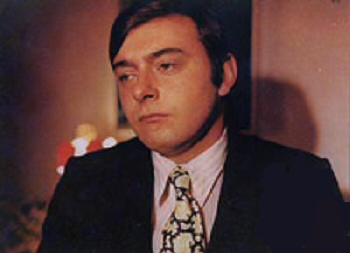 I'd been avoiding this Fassbinder film for no good reason. It's funny: this is probably the most stylistically detached of his earlier work. In the first phase of his career, RWF was aggressively experimental, and after the Godard-biting of Love is Colder Than Death, the staginess of Katzelmacher and the formality of Gods of the Plague, Herr R (his first color film, shot in 16mm) is a bolder move into the recognizable Fassbinder approach...even though it's very different from what he would end up doing (stay with me here - I'm trying to figure this out myself.) Kurt Raab plays Kurt Raab, a married engineer with a child who lives a quiet life of family, friends and work. Fassbinder uses the title as a kind of tease: the entire film, I was waiting for Herr R. to start running amok - that anxiety aided by Raab, who looks like the guy on the bus you're watching carefully because you know he's gonna do something (and fans of Satan's Brew know he's capable of excessive mania.)
I'd been avoiding this Fassbinder film for no good reason. It's funny: this is probably the most stylistically detached of his earlier work. In the first phase of his career, RWF was aggressively experimental, and after the Godard-biting of Love is Colder Than Death, the staginess of Katzelmacher and the formality of Gods of the Plague, Herr R (his first color film, shot in 16mm) is a bolder move into the recognizable Fassbinder approach...even though it's very different from what he would end up doing (stay with me here - I'm trying to figure this out myself.) Kurt Raab plays Kurt Raab, a married engineer with a child who lives a quiet life of family, friends and work. Fassbinder uses the title as a kind of tease: the entire film, I was waiting for Herr R. to start running amok - that anxiety aided by Raab, who looks like the guy on the bus you're watching carefully because you know he's gonna do something (and fans of Satan's Brew know he's capable of excessive mania.)
But the film, which is made up of roughly a dozen scenes shot on hand-held camera and graviates unfocusedly from person to person (often not staying on the character speaking, or Herr R., or the main action of the scene) made a deliberate attempt to capture very little. Dreary office routines, get-togethers centered on inane chatter in the living room, parent conferences at the child's school...in other words, everyday life. Fassbinder referred to this as a "disgusting" film, and it's clear that he finds this ritualistic mediocrity unbearable. The movie suggests an escape to an almost childlike state of carelessness and irrationality, the same kind that fueled the passion of its director: the title should be Why Did Herr F Run Amok? That this theory of liberated regression would lead to murder and suicide (and who watching one of Fassbinder's movies hasn't fantasized of braining Irm Hermann mid-sentence?) is played out like an exquisite rapture: Raab even gets the camera's attention and it follows him around, as though the previously bored and restless Fassbinder lens was suddenly captivated. Although the movie is more of a stepping stone to greater works, there are scenes that rank with the director's finest, especially one in the record store where Raab is trying to describe the song he liked to a pair of giggling clerks.
<<click here for 11/2/6 - 11/09/6>>
home about contact us featured writings years in review film productions
All rights reserved The Pink Smoke © 2008